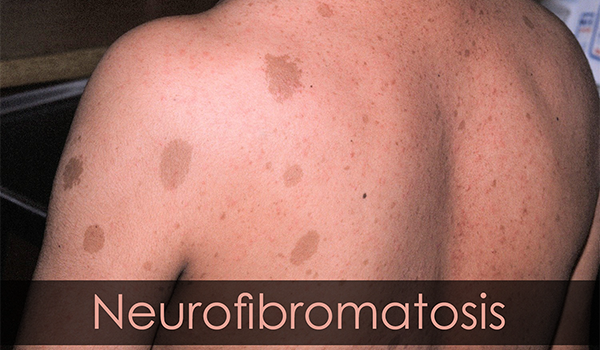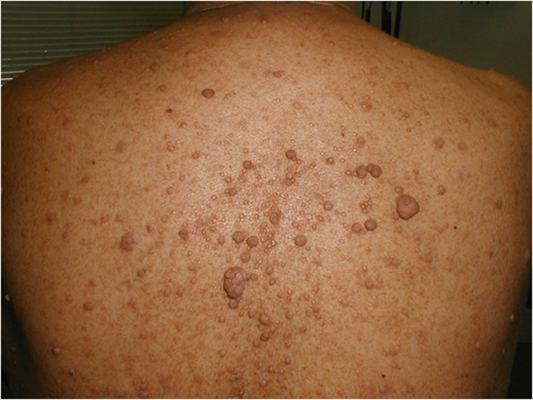Ayurvedic Treatment of Neurofibromatosis

Abstract
Neurofibromatosis is a rare condition which is also known as multiple inherited schwannomas, meningiomas and ependymomas. Some also named it as Von Recklinghausen’s disease. It is a genetic condition which may be inherited or can arise spontaneously. The main manifestation of the condition is bilateral development of benign brain tumors in nerve sheaths which usually involve the eighth cranial nerve (auditory vestibular nerve). This nerve is responsible for transmitting sensory information from the inner ear to the brain. In this article we will discuss neurofibromatosis in detail which will include its cause, classification, pathogenesis, symptoms, diagnosis. The treatment will involve explanation of both ayurvedic and modern medications.

Introduction
The condition is bizarre as it is rare. Neurofibromatosis is having two major features which includes
- Multiple neural tumors dispersed anywhere on or in the body
- Numerous pigmented skin lesions, some of which are ‘Cafe au lait’ (brown spots) spots.
A bewildering assortment of other abnormalities may accompany these cardinal features. While approximately 50% of the patients have a definite family history consistent with autosomal dominant transmission, about half the patients appear to represent new mutations, perhaps affecting the same gene or genes. Neurofibromas arise within or attached to nerve trunks anywhere in the skin, including the palms and soles, as well as in every conceivable internal site, including cranial nerve particularly the acoustic nerve.
Classification
There are two main classifications for this condition:
- Wishart Phenotype: It is characterized by multiple cerebral and spinal lesions. This is usually present in people younger than 20 years of age and has a rapid progression.
- Feiling Gardner Phenotype: They develop single central tumors with slow progression and appear after the age of 20 years.
Causes
The only cause of this condition is gene mutation. The mutation is observed on chromosome 22 and also involves a protein called merlin. It is involved in cell shape and cell structure.
Pathogenesis
Neurofibromatosis is the result of a gene defect or usually gives rise to a product called merlin or schwannomin. Merlin is located on chromosome 22. In initial studies, Merlin was described as a structural protein that behaves as a cytoskeleton regulator. But later its tumor suppressant role was described. It regulates multiple proliferating signaling cascades that inhibit the invasion of tumors.
Characteristics of Neurofibromas
- On the surface of the body they generally occur in profusion and range from discrete, soft, yielding, subcutaneous nodules less than 1 cm in diameter to moderate size pedunculated masses, 20 or more centimeters in greatest diameter.
- Similar Tumors may occur internally and in general the deeply situated lesions tend to be large.
- If grossly examined the neurofibromas vary from spherical to cylindrical to beaded, sometimes tortuous masses. They may or may not be encapsulated.
- This also tends to show transformation to malignant neurofibromas in about 10-15% cases.
- Malignant transformation is most common in the very large tumors attached to large nerve trunks of the neck or extremities. The superficial lesions despite their size rarely become malignant.
Symptoms of Neurofibromatosis
- Varying size of neurofibromas.
- Cutaneous pigmentations, is the second major component of this syndrome, and are present in over 90% of patients. They commonly appear as light brown ‘cafe au lait’ macules, with generally smooth borders often located overlying nerve trunks.
- Their shape is generally round to ovoid, with their long axes parallel to the underlying cutaneous nerve.
- Clinically if more than five cafe au lait spots are present over the patient’s body he or she is likely to have neurofibromatosis.
- Hearing loss can also be noticed.
Associated Abnormalities
These are common in around 30 -50% of the population having neurofibromatosis.
- Erosive defects due to contiguity of neurofibromas to bones.
- Scoliosis
- Intraosseous cystic lesions
- Sub periosteal bone cysts
- Pseudoarthrosis of the tibia
Diagnosis
History
Family history of such condition. There are three sets of diagnosis given by Ferner:
- Unilateral vestibular schwannomas or Bilateral vestibular schwannomas associated with meningioma, glioma, neurofibroma.
- Unilateral VS with any two of meningioma, glioma, neurofibroma.
- Two or more meningioma plus U/L vestibular schwannomas.
Treatment
Surgery is the primary approach in such cases and the commonest approach for vestibular schwannomas. Bevacizumab is known to reduce the tumor growth rates. It also helps in hearing improvements.
Herbal Remedies by Planet Ayurveda
Planet Ayurveda is a GMP certified herbal manufacturing company that deals with the preparation of herbal products. These products are manufactured using potent herbs and their standardized extracts. Planet Ayurveda products are very effective and do not cause any side effects. Following are some products that can be used for the management of this condition:
- Amalaki Rasayan
- Ashwagandha Capsules
- Brahmi Capsules
- Neuroplan Syrup
- Rasraj Ras
- Vrihat Vatchintamani Ras
Products Description
1. Amalaki Rasayan
Amalaki (Emblica officinalis) rasayan’s daily use improves immunity, fights cancers and rejuvenates. It also has antioxidants, immunomodulatory, and analgesic effects. Amalaki rasayan also has cytoprotective properties and strengthens the body.
Dose: One capsule twice a day after meals.
2. Ashwagandha Capsules
This is a single herbal formulation prepared using the standardized extract of Withania somnifera which is a herb that helps in increasing the body’s Immunity and is often known as sharir pushtikarak. Ashwagandha is a herb known from ages to increase the body’s metabolism and thus provide with improved and stable immunity which is very important in order to avoid development of neurofibromatosis.
Dose: One capsule twice a day after meals.
3. Brahmi Capsules
The preparation of these capsules uses standardized extract of brahmi. Brahmi is very useful in neurodegenerative conditions as well helps in protecting the body from various other conditions too. In neurofibromatosis it assists in reducing the pace of fibroma growth and thus prevents gradual hearing loss.
Dose: One capsule twice after meals daily.
4. Neuro Plan Syrup
Neuro plan is manufactured using brahmi (Bacopa monnieri), Mandukaparni (Centella asiatica), Shankhpushpi (Convolvulus pluricaulis), Sonth (Zingiber officinale) and many more. It helps in relieving weakness of nerves in this condition. Neuro plan syrup is very efficient and gives desirable results.
Dose: Two tsp twice a day after meals.
5. Rasaraj Rasa
Rasraj ras is a polyherbal classical ayurvedic formulation prepared using Rasa sindura (Purified and processed Mercury), Abhrak satva (Purified and processed Silica, Swarna Bhasma (Gold Bhasma), Loha Bhasma (Iron Bhasma), Rajata Bhasma (Silver Bhasma) and many more. It also helps in maintaining nerve strength and promotes nerve health. It aids in reducing the growth rate of neurofibroma and thus provides relief to patients.
Dose: Two tablets twice a day after meals.
6. Vrihat vatchintamani Ras
This herbo-mineral formulation contains Loha Bhasma, Swarna Bhasma, Rajata Bhasma, Abhraka Bhasma and many more. It enhances brain functioning and also helps in rejuvenation of cells. Swarna bhasma is best known to enhance the immunity of the body.
Dose: One tablet twice daily to be chewed after meals.
Contact my team to provide you the costing / ordering and delivery information at – costing.planetayurveda@gmail.com or call at +91-172-5214030 Or Check Website – www.PlanetAyurveda.com
Conclusion
Neurofibromatosis is a rare condition that runs in families. The inhibition of merlin is the main cause of this condition and this inhibition is the result of gene mutation. The management of such conditions require time and patience both by the physician and the patient. In case of any query kindly visit www.planetayurveda.com and ask your questions in the query box.





